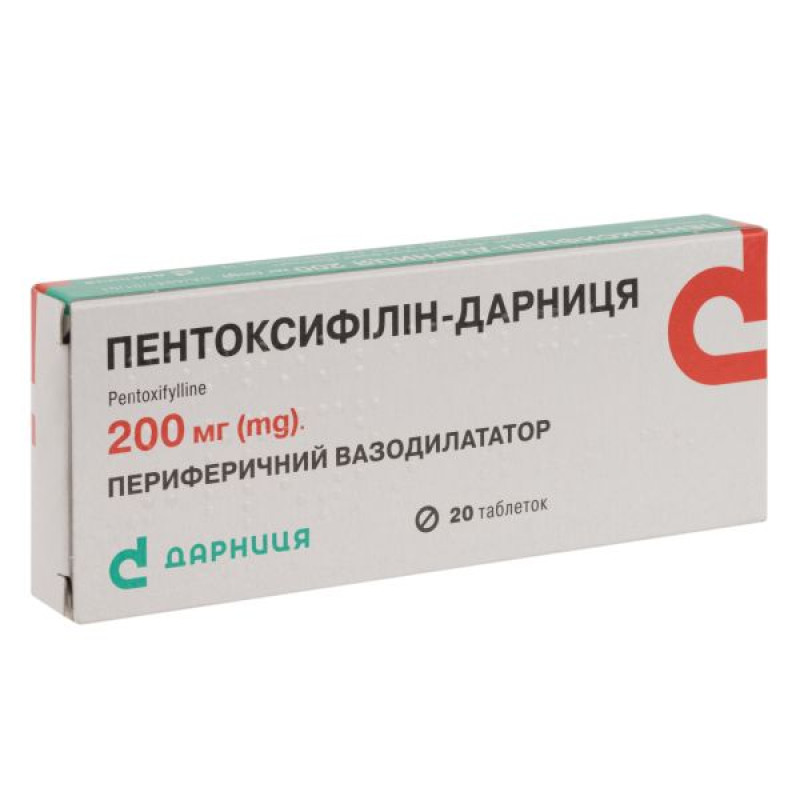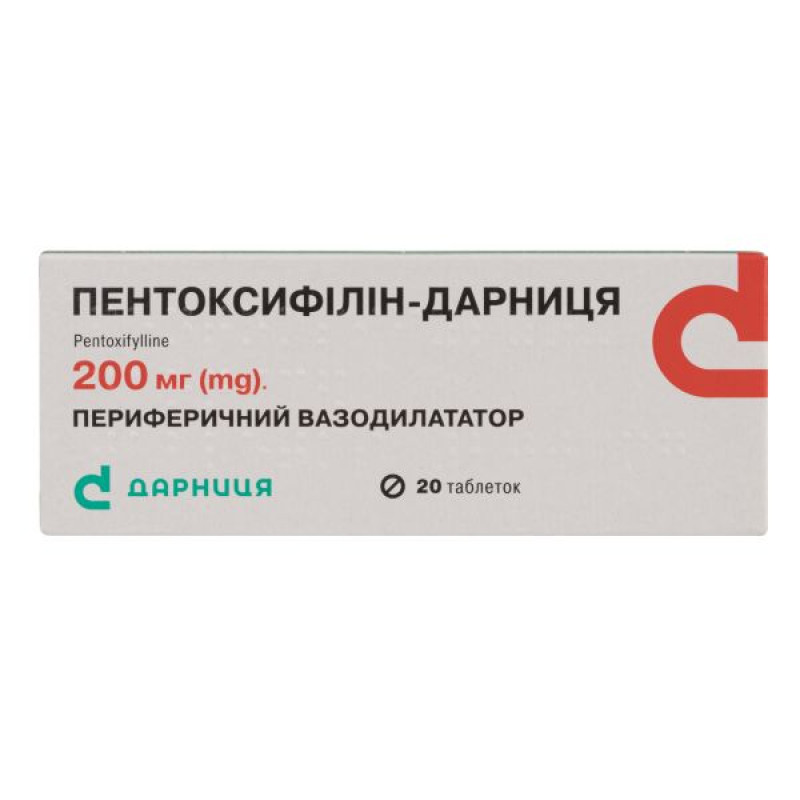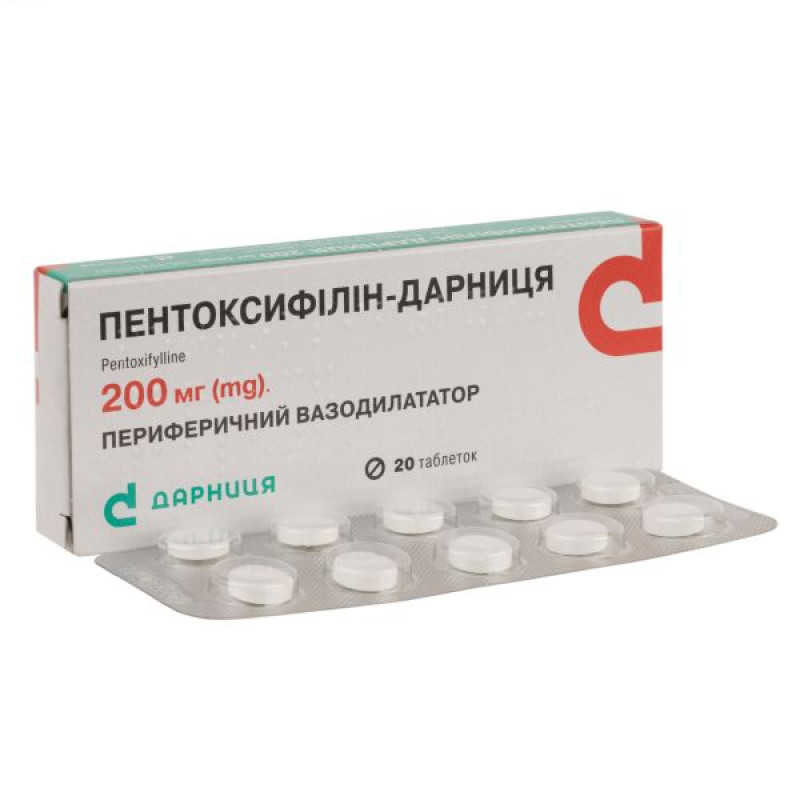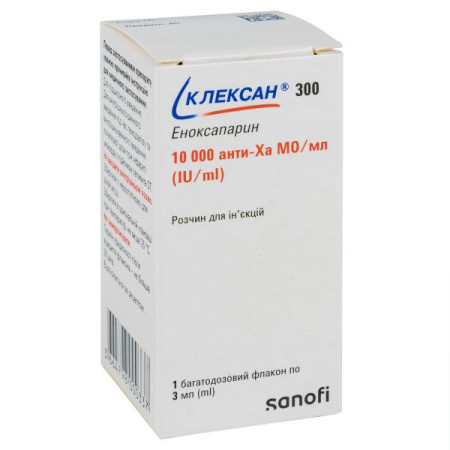Pentoxifylline-Darnitsa tablets 200 mg No. 20

Instructions for use Pentoxifylline-Darnitsa tablets 200 mg No. 20
Composition
active ingredient: pentoxifylline;
1 tablet contains 200 mg of pentoxifylline;
Excipients: lactose monohydrate, potato starch, povidone, calcium stearate.
Dosage form
Pills.
Main physicochemical properties: white tablets, round in shape, with a flat surface, a bevel and a score.
Pharmacotherapeutic group.
Peripheral vasodilators. ATX code C04A D03.
Pharmacological properties
Pharmacodynamics.
Pentoxifylline is a methylxanthine derivative. The mechanism of action of pentoxifylline is associated with the inhibition of phosphodiesterase and the accumulation of cAMP in vascular smooth muscle cells, blood cells, as well as in other tissues and organs. Pentoxifylline inhibits platelet and erythrocyte aggregation, increases their flexibility, reduces the increased concentration of fibrinogen in blood plasma and enhances fibrinolysis, which reduces blood viscosity and improves its rheological properties. In addition, pentoxifylline causes a weak myotropic vasodilator effect, slightly reduces total peripheral vascular resistance and has a positive inotropic effect. As a result of the use of pentoxifylline, microcirculation and tissue oxygen supply improve, most notably in the extremities, central nervous system, moderately in the kidneys. The drug slightly dilates coronary vessels.
Pharmacokinetics.
After oral administration of 100 mg of pentoxifylline, the drug is almost completely absorbed from the gastrointestinal tract. The maximum concentration of pentoxifylline and its main metabolite (metabolite I) is recorded 1 hour after administration. The drug is characterized by the phenomenon of "first pass" through the liver. The bioavailability of the unchanged substance is on average 19% (varies from 6% to 32%). The main pharmacologically active metabolite 1-(5-hydroxyhexyl)-3,7-dimethylxanthine (metabolite I) is determined in blood plasma at a concentration that is 2 times higher than the concentration of the unchanged substance and is in a state of reverse biochemical equilibrium with it. Pentoxifylline and its metabolite should be considered as an active whole, therefore it can be assumed that the bioavailability of the active substance is significantly higher.
The half-life of pentoxifylline is 1.6 hours.
Pentoxifylline is completely metabolized, more than 90% is excreted by the kidneys in the form of unconjugated water-soluble polar metabolites. Less than 4% of the administered dose is excreted in the feces. In patients with severe renal impairment, excretion of metabolites is slowed down. In patients with impaired liver function, an increase in the half-life of pentoxifylline and an increase in its bioavailability are noted.
Indication
Atherosclerotic encephalopathy; ischemic cerebral stroke; dyscirculatory encephalopathy; peripheral circulatory disorders caused by atherosclerosis, diabetes mellitus (including diabetic angiopathy), inflammation; trophic disorders in tissues associated with damage to veins or impaired microcirculation (postthrombophlebitic syndrome, trophic ulcers, gangrene, frostbite); obliterating endarteritis; angioneuropathy (Raynaud's disease); eye circulatory disorders (acute, subacute, chronic circulatory insufficiency in the retina and choroid); inner ear dysfunction of vascular genesis, which are accompanied by hearing loss.
Contraindication
Hypersensitivity to pentoxifylline, to other methylxanthines or to any of the excipients; massive bleeding (risk of increased bleeding); retinal hemorrhages; if retinal hemorrhage occurs during treatment with pentoxifylline, the drug should be discontinued immediately; cerebral hemorrhage; hemorrhagic diathesis; acute myocardial infarction; gastric ulcer and/or intestinal ulcers.
Interaction with other medicinal products and other types of interactions
Pentoxifylline enhances the effect of antihypertensive and other vasodilators (ACE inhibitors, nitrates), which can cause severe arterial hypotension. With simultaneous use with adrenergic drugs and ganglioblockers, a significant decrease in blood pressure may be observed.
Concomitant use of adrenergic substances or xanthines leads to excitation of the central nervous system.
Higher doses of pentoxifylline potentiate the effect of insulin and oral hypoglycemic agents. Due to the risk of hypoglycemia, it is recommended to measure blood glucose levels more frequently and adjust antidiabetic therapy over time.
Pentoxifylline increases the incidence of bleeding complications in patients treated concomitantly with anticoagulants, antiplatelet agents and thrombolytic agents. Patients treated concomitantly with anticoagulants should have their prothrombin time measured more frequently.
Cimetidine increases the concentration of pentoxifylline in the blood plasma, which increases the risk of adverse reactions. Other H2-receptor antagonists (famotidine, ranitidine and nizatidine) have a much smaller effect on the metabolism of pentoxifylline.
Concomitant use of pentoxifylline and theophylline may lead to an increase in theophylline serum concentration. Therefore, it is necessary to monitor the serum theophylline concentration and, if necessary, reduce its dose.
Concomitant use of pentoxifylline and ketorolac may lead to an increase in prothrombin time and increase the risk of bleeding. The risk of bleeding may also increase with the concomitant use of pentoxifylline and meloxicam. Therefore, concomitant treatment with these drugs is not recommended.
Ciprofloxacin inhibits the metabolism of pentoxifylline in the liver, therefore, simultaneous administration of pentoxifylline and ciprofloxacin may lead to an increase in the concentration of pentoxifylline in the blood serum. If simultaneous treatment with pentoxifylline and ciprofloxacin is necessary, it is recommended to halve the dose of pentoxifylline.
Antacids: For patients with gastrointestinal side effects, antacids may be administered with pentoxifylline. In a comparative bioavailability study, antacids did not alter the absorption of pentoxifylline.
Application features
At the first signs of an anaphylactic/anaphylactoid reaction, treatment with the drug should be discontinued and medical attention should be sought.
When using pentoxifylline in patients with chronic heart failure, the phase of circulatory compensation should first be achieved.
In patients with diabetes mellitus treated with insulin or oral antidiabetic agents, the effect of these agents on blood sugar levels may be increased when high doses of the drug are used (see section "Interaction with other medicinal products and other types of interactions"). In these cases, the dose of insulin or oral antidiabetic agents should be reduced and the patient should be particularly carefully monitored.
The drug should be used with caution in patients receiving concomitant treatment with pentoxifylline and ciprofloxacin (see section "Interaction with other medicinal products and other types of interactions").
Patients with systemic lupus erythematosus (SLE) or other connective tissue diseases should be prescribed pentoxifylline only after a thorough analysis of the possible risks and benefits.
Since there is a risk of developing aplastic anemia during treatment with pentoxifylline, regular monitoring of complete blood counts is required.
In patients with renal insufficiency (creatinine clearance less than 30 ml/min) or severe liver dysfunction, the elimination of pentoxifylline may be delayed. Appropriate monitoring is required.
Particularly careful observation is necessary for:
patients with severe cardiac arrhythmias; patients with myocardial infarction; patients with arterial hypotension; patients with severe atherosclerosis of cerebral and coronary vessels, especially with concomitant arterial hypertension and heart rhythm disturbances. In such patients, angina attacks, arrhythmias and arterial hypertension are possible when taking the drug. patients with renal failure (creatinine clearance below 30 ml/min); patients with severe hepatic failure;
patients with a high tendency to bleed, for example due to anticoagulant treatment or blood clotting disorders. For bleeding, see section "Contraindications";
patients with a history of gastric and duodenal ulcers, patients who have recently undergone surgical treatment (increased risk of bleeding, which requires systematic monitoring of hemoglobin and hematocrit levels);
patients receiving concomitant treatment with pentoxifylline and vitamin K antagonists (see section “Interaction with other medicinal products and other types of interactions”);
patients receiving concomitant treatment with pentoxifylline and antidiabetic agents (see section "Interaction with other medicinal products and other types of interactions").
The drug contains lactose, therefore patients with rare hereditary forms of galactose intolerance, lactase deficiency or glucose-galactose malabsorption syndrome should not use the drug.
Use during pregnancy or breastfeeding
Since there is insufficient experience with the use of pentoxifylline in pregnant women, it should not be prescribed during pregnancy.
Pentoxifylline passes into breast milk in small amounts. If treatment with the drug is necessary, breastfeeding should be discontinued.
Ability to influence reaction speed when driving vehicles or other mechanisms
Considering that sensitive patients may experience adverse reactions (dizziness, blurred vision) when using the drug, they should refrain from driving vehicles and performing other work that requires concentration of attention during the period of taking the drug.
Method of administration and doses
In case of arterial hypotension, negative reactions from the gastrointestinal tract or central nervous system, the initial dose may be reduced to 100 mg of pentoxifylline 3 times a day.
In case of impaired renal function (creatinine clearance < 30 ml/min), a dose reduced by 50-70% is used, according to individual sensitivity.
Patients with severe hepatic dysfunction also require a dosage reduction according to individual sensitivity.
In patients with arterial hypotension, as well as in patients at risk of a sharp decrease in blood pressure (for example, with coronary artery disease or with severe cerebral artery stenosis), treatment should be started with low doses, gradually increasing them until a therapeutic effect is achieved.
The tablet formulation may be administered as an adjunct to parenteral administration or as maintenance therapy following intravenous administration.
The duration of treatment is determined by the doctor individually.
Children
The drug is not indicated for use in children.
Overdose
Symptoms: Initial symptoms of acute pentoxifylline overdose may include nausea, dizziness, tachycardia or decreased blood pressure. Later, fever, agitation, flushing, loss of consciousness, areflexia, tonic-clonic convulsions and "coffee-ground" vomiting as a sign of gastrointestinal bleeding may occur.
Treatment: In case of overdose, further systemic absorption of pentoxifylline should be stopped by primary removal (e.g. gastric lavage) or by delaying its absorption (e.g. activated charcoal). There is no specific antidote known.
In order to treat acute overdose and prevent complications, general and specific intensive medical observation and therapeutic measures are necessary.
Adverse reactions
Some patients may experience side effects of the drug, namely:
Nervous system: headache, dizziness; anxiety, restlessness, sleep disturbances; convulsions; aseptic meningitis (when taking high doses), tremor, paresthesia, agitation, hallucinations;
Skin: allergic skin reactions, hyperemia of the skin of the face (hot flashes) and upper chest, edema, increased brittleness of nails, rashes (including vesicular).
from the digestive tract: gastrointestinal disorders, abdominal pain, nausea, vomiting, diarrhea, anorexia, intestinal atony, constipation, intrahepatic cholestasis, exacerbation of cholecystitis, cholestatic hepatitis, dry throat, thirst, feeling of pressure in the stomach, flatulence;
from the sensory organs: visual impairment, blurred vision, scotoma, lacrimation, conjunctivitis, earache, migraine, retinal hemorrhages, retinal detachment;
Cardiovascular system: tachycardia, arrhythmia, cardialgia, peripheral edema, angina pectoris, decreased blood pressure, increased blood pressure, shortness of breath, hemorrhage (e.g., into the skin, mucous membranes, stomach, intestines).
from the blood system and blood-forming organs: thrombocytopenia with thrombocytopenic purpura, leukopenia, pancytopenia, which can be fatal, hypofibrinogenemia, anemia, aplastic anemia; bleeding from the vessels of the skin, mucous membranes, stomach, intestines, nose;
from the immune system: allergic reactions, including anaphylactic and anaphylactoid reactions, angioedema, bronchospasm and anaphylactic shock, itching, skin hyperemia, urticaria, rash, toxic epidermal necrolysis (Lyell's syndrome) and Stevens-Johnson syndrome;
others: taste disturbance, drooling, malaise, enlargement and tenderness of glands in the throat and neck, laryngitis, nasal congestion, weight loss/gain, fever, hyperthermic syndrome, hypoglycemia, increased sweating; laboratory parameters: increased activity of hepatic transaminases (ALT, AST, LDH) and alkaline phosphatase.
Expiration date
3 years.
Storage conditions
Store in the original packaging at a temperature not exceeding 25 °C.
Keep out of reach of children.
Packaging
10 tablets in a contour blister pack; 2 contour blister packs in a pack.
Vacation category
According to the recipe.
Producer
PrJSC "Pharmaceutical Company "Darnitsa".
Location of the manufacturer and its business address
Ukraine, 02093, Kyiv, Boryspilska St., 13.
There are no reviews for this product.
There are no reviews for this product, be the first to leave your review.
No questions about this product, be the first and ask your question.










